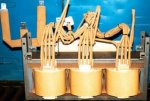The application is a 25kv/480 Pad Mounted Transformer feeding a MCC (w/ Main Breaker) approximately 150 ft away. There is no Secondary OCD at the Transformer. The XO is connected to a High Resistance Ground (Post Glover) in the MCC. The Transformer HO is connected to both the POCO ground and the Plant grounding grid.
The question is: should the POCO grounding conductor be connected to the Plant grounding grid or should the two be isolated from each other? I've studied for months to find the answer and still don't have a clear understanding. Thanks
The question is: should the POCO grounding conductor be connected to the Plant grounding grid or should the two be isolated from each other? I've studied for months to find the answer and still don't have a clear understanding. Thanks


